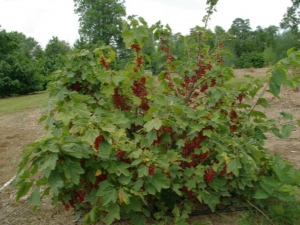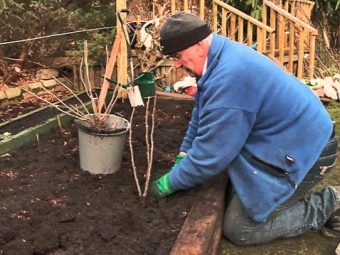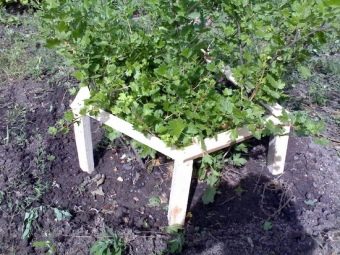Rules and terms of transplanting currants

Every gardener who grows currants knows that this crop requires constant care. But in order to get a rich harvest, it is necessary to carry out time to transplant currant bushes. When is it better to replant currants, in spring or autumn? How to care for transplanted plants?
Optimal time
Before being determined with the time of transplantation of currant bushes, You should find out the reasons why this procedure is necessary:
- Often, transplanting plants is necessary in order to increase the number of shrubs of a certain variety;
- if the bush is constantly exposed to fungal diseases, and at the old landing site, the treatment does not give positive results;
- over time, the bushes begin to grow very densely, while interfering with each other’s normal development;
- such a need happens if the groundwater level has risen sharply for some reason;
- in the event that a currant grows on the same place for a long time, there is a gradual depletion of the soil, which does not give the plant a sufficient amount of nutrients, while the berry yield is significantly reduced;
- A currant transplant is also necessary if there are located near a farm building or tall trees that shade the crop, preventing the sun from penetrating.
Any currant (red, white, black) painfully tolerates the transplanting procedure, therefore it is necessary to take into account the peculiarities of one or another variety. But at what time is it best to transplant a shrub to get an early harvest? Experts can not give a definite answer to this question. For one case, the autumn transplant is considered the ideal option, and for the other, the spring one. The procedure of planting at different times of the year will be identical; seasonal transplants differ only in subsequent care of the crop.
To choose the right time for transplanting, it is necessary to take into account the climatic conditions of the area where currants are grown.
In harsh climatic conditions, it is recommended to transplant in spring, when the snow melted and the positive temperature outside normalized. But when the bush has already begun to grow and develop, it is worth postponing the planting until autumn. The autumn period also requires certain observance of the rules, because at the same time the shrub must completely get rid of leaf plates, and the shoots stop the movement of juices.
Autumn transplantation has certain advantages over spring, because at this stage, currant bushes contain a large amount of nutrients that contribute to the accelerated healing process of wounds, and the recovery process is much easier. The optimal period for replanting currant bushes in central and southern Russia is considered to be mid-September (from 10 to 15 number).
Spring transfer
It is better to carry out a spring transplant during a period when the temperature outside is about 0 or +5 degrees. The main thing is that the kidneys do not have time to swell. At the same time, the period for plant transplantation is minimal, so if it is not possible to perform activities during this period, then it is better to transfer the transplant to autumn. Experts do not recommend to replant flowering currant bushes, they will be attacked by fungal diseases and drop flowers.
In the spring, it is better to transplant young bushes formed from cuttings or rooted cuttings. The harvest at such a planting should be expected no earlier than a year later, during which time the plant will take root and pick up a sufficient amount of nutrients.
Autumn transplant
For such a transplant, it is very important that the right time is chosen. Before the onset of frost should be at least 3 weeks. With early planting, the plant may confuse the seasons, putting buds in the winter, so the plant may die.With a late transplant, the root system will not have time to settle down. On time, the planted plant should have time to take root, so that in the spring it starts to actively develop, bringing a rich harvest. Before the onset of frost, currant bushes must be covered with insulating materials. On the soil around the stem you need to pour 10-20 kg of humus.
If autumn is dry and without rain, then before the onset of the first frost, transplanted shrubs should be watered abundantly with warm water.
Is it possible to transplant currant bushes in the summer?
Experienced gardeners do not recommend replanting this crop in summer, but there are situations when there is no choice. Adult shrubs should be dug so that the root system is along with the soil. The more land you dig along with the bush, the greater the likelihood that replanting will yield positive results. In hot weather will require abundant watering for the bush, otherwise the plant does not take root, and dries.
Experts believe that summer is not the right time for transplanting berry bushes. Even in the event that you have watered abundantly on a transplanted plant that contains a large number of leaf plates. In case of hot heat, the bush simply will not sustain such a load, as a result of which there is a risk of losing the berry crop.
Seedlings purchased in special nurseries, which are sold in containers, can be replanted at any time of the year. The main thing is to ensure a sufficient amount of moisture, as well as the introduction of fertilizing.
After transplanting such plants, it is necessary to mulch the earth with humus, peat or sand mixture. Similarly, you retain moisture in the soil. If the planting wells are immediately filled with fertilizers, then the application of fertilizers can be postponed to the next year.
How to choose a place?
When choosing a new place for berry bushes, it is necessary to take into account the peculiarities of the variety. After all, black currants can be planted in almost any soil, and the red one should be planted in sandy soil. This is due to the fact that this variety of berries does not tolerate an excessive amount of moisture in the soil. In such conditions, the plant is constantly sick, not bringing a normal harvest. To choose the right place for planting a blackcurrant bush, you should pay attention to some nuances.
- First of all, the place should be well lit by sunlight. Black currants can be planted in a semi-dark place, but red currants should be planted only on the south side of the area where there is no blackout.
- If the site is located in a lowland or in a swampy area, then the currant bush on such a site will constantly be exposed to fungal diseases, and an excess of moisture will lead to rotting of the root system. But shrubs too high should not be placed either; permanent winds will negatively affect ripe berries, as well as blow all moisture out of the ground.
- As "neighbors" you can use potatoes or legumes. Do not plant shrubs where there is a large number of weeds or tall fruit trees. Being close to such crops, the shrub will significantly reduce fruiting.
- The distance between the transplanted bush and other bushes must be at least 1.5 meters. The berry plant has a low resistance to diseases with which it can be infected from neighboring fruit plants.
- Currant bushes do not tolerate the proximity of groundwater, they should be at a depth of 1-1.5 meters from the surface of the earth. To determine their location, you should pay attention to the weeds growing on the site. Where wormwood grows, the distance from the ground to groundwater is 5 meters, cattail - 1 meter, reed or groundwind - 1.5-3 meters.
Transplant stages
There are 3 types of transplant currant crops:
- shrub dividing;
- layering;
- green cuttings (in late May - early June).
The last breeding variation is suitable for extreme situations, for example, you urgently needed to free the plot from currants or it is constantly exposed to diseases on the old soil, where transplantation is the only way out. Once you have decided on the transplant site, you can begin the process of transplanting currant bush. Let us consider in detail the transplant of a plant in the autumn period with the help of dividing a bush.
- The first step is to free the site from various weeds and debris. It is advisable to do this for 10-20 days before transplantation, thus, the soil is ventilated and warmed.
- Pits are dug so that the distance between them is at least 1 meter. If you plant large shrubs, then the distance between them is better to increase. The hole should be from 0.5 to 0.6 m in diameter and 0.3-0.4 m in depth. Experts recommend digging a hole to the size of the root system.
- At the bottom of the pit is laid drainage layer of 7-8 centimeters, which should include gravel and sand. The ground that was removed from the pit should be mixed with wood ash, humus and potash or phosphate fertilizers. But be careful when adding the last ingredients, an excessive amount will destroy the plant. Preparation of a mixture of soil and fertilizer should be carried out strictly according to the instructions.
- 2/3 of the pit is filled with the prepared mass from the ground. After it is necessary to pour abundantly with warm water, if the earth is quickly absorbed by the liquid, then the procedure should be repeated.
- Currant bush completely need to get rid of old branches, and young shoots pruned to half. A viable plant should have a strong root system consisting of 2 or 3 branches ranging from 15 to 25 centimeters. For transplantation, the best options are considered seedlings, whose age does not exceed 3 years. The quality of seedlings can be checked for the condition of the bark: it should be smooth green. In unsuitable seedling bark brown shade.
- The excavated shrub is carefully inspected so that there are no harmful insects or larvae on it. If the kidneys are swollen, it means that harmful microorganisms have settled inside. Otherwise, it is necessary to treat the plant with specialized means. Potassium permanganate solution is considered to be the most effective and safe means.
- Water is poured into the prepared hole in order to form a mud of liquid consistency at the bottom. After the shrub is set in an upright position, the remaining earth is poured. At the same time make sure that there are no voids, it is constantly necessary to tamp the ground. The neck of the root system plunges into the depth of 7-9 centimeters.
- A mixture of humus, peat, and dry leaves is poured over the ground to prevent the top layer of soil from drying out. Planted shrubs should be plentifully watered within 3-4 days. When the planting procedure is over, it is necessary to prune the kidneys. Bush is trimmed to 4 or 5 buds, while the crown is cut almost the entire amount.
This procedure is necessary so that new and healthy kidneys actively develop. If this is not done, the crown will pull out all the nutrients from the root system, preventing normal survival in the new section. As a result, the plant will develop improperly, most leaf plates will dry up, and the bush itself will be sick for the whole season, without bringing enough berries.
Aftercare
After performing operations on transplanting currant bushes will require regular care. The soil that is near the main trunk must be kept loose. This is necessary to normalize the amount of water and oxygen that must be present in the soil for the active development of the shrub.Loosening the ground near the base of the currant crop lays to a depth of 5 to 7 cm, and in the place where the watering hole is located, the depth of loosening increases to 15 centimeters.
If currant seedlings were transplanted in the fall, then they should be spud immediately after planting, thanks to this procedure, the plant is much easier to endure harsh weather. At the beginning of the spring period, the ground around the trunk should be leveled to prevent the shoots from entering the area. Indeed, at such a distance from the surface of the earth, the shoots will freeze out at the first frosts. Autumn bushes need to prepare for winter:
- the area near the trunk is cleaned from fallen leaves and other plant waste;
- after laying a layer of mulch, which consists of peat (thickness about 15 cm);
- carry out the irrigation procedure with fungicides strictly according to the instructions;
- spreading branches should be collected in one bundle, tied up with a rope.
Within 2 weeks after transplanting spend abundant watering of plants. Each bush needs to be watered through the day with 30-40 liters of settled liquid or water at room temperature.
Tips
Use the advice of experienced gardeners, to transplanted currant bushes settled down without problems.
- Since the autumn transplantation of berry bushes will require further shelter for the winter period, it is not necessary to use freshly mown grass, tops or leaves as a warming material. Such ingredients will only attract rodents that are able to destroy the currant root system.
- It is not recommended to perform a currant transplant to the area where the same culture had previously grown. It is better to choose a new place for transplantation, because in this way you will not let the ground overwork, and you will not expose the plant to diseases that are left of old plants.
- When transplanting currant bushes, it is prohibited to use fresh manure as a fertilizer. This ingredient will prevent the removal of excess moisture from the soil, and this will lead to rotting of the root system.
- If you replant at the same time several varieties of currants, they should be planted next to each other. Thus, you will increase the yield and size of the fruit, because there will be cross-pollination of plants.
When planting currants in the spring there is a risk of attacks of harmful insects. To prevent such attacks, experienced gardeners recommend planting spicy crops (garlic, parsley, basil) next to seedlings, whose sharp aroma will deter pests.
To learn how to transplant currants, see the next video.









































